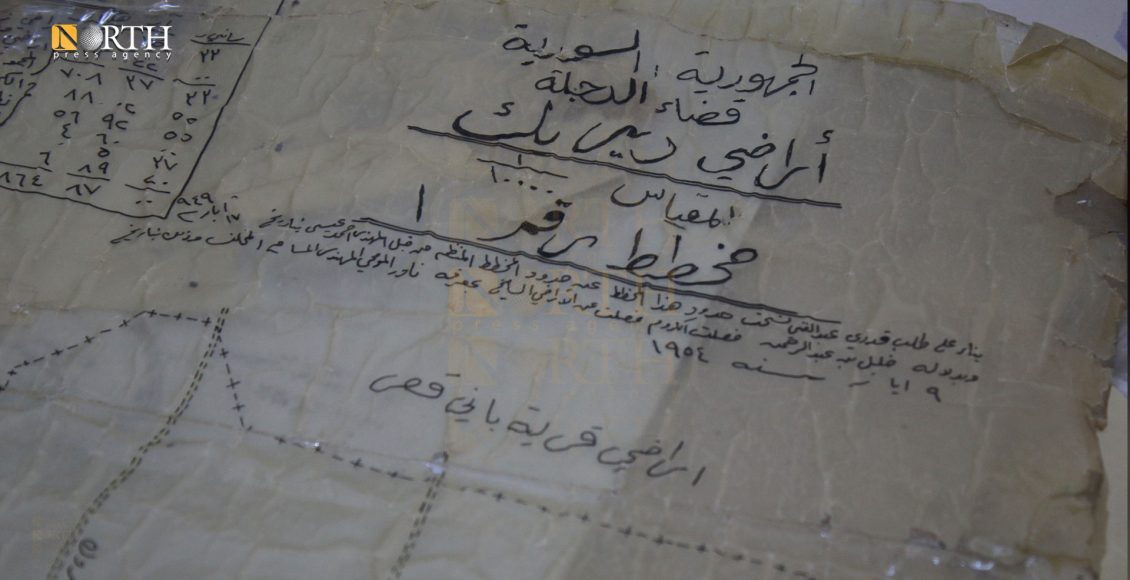“Syrian Republic” in documents of first plan for NE Syrian city
QAMISHLI, Syria (North Press) – Seventy-five years ago, the first official plan for the city of Derik (al-Malikiyah) in the far northeast of Syria, was drafted. According to documents from the time, as revealed by the daughter of one of the city’s founders, these state records—shared exclusively with North Press—refer to the country as the “Syrian Republic” before the term “Arab” was added to the state’s name during the Baath regime’s rule under the Assads.
Amid the protests that erupted in Syria in 2011, demonstrators adopted the flag of independence, which was the flag of the Syrian Republic (1932-1963), also known as the First Syrian Republic.
Historical context of the “Syrian Republic”
Fatima Abdel Ghani, daughter of Haj Abdul Rahman—one of Derik’s founders—holds in her hand a document detailing the first official plan for the city, organized in 1949. This document illustrates the city’s terrain and landmarks, including the river running through its center and the French military orchard that stood as one of its prominent features at the time.
In an interview with North Press, Fatima, now in her seventies, explained: “In the documents we possess, the state is referred to as the Syrian Republic, and the city’s name is Derik, with Kurdish names for all the surrounding villages. These are official, state-recognized documents.”
Syria is home to a rich mosaic of religious and ethnic communities, reflecting the country’s diverse cultural and religious heritage. Each of these communities has its own distinct history and cultural identity.
Fatima continued, “The relationship between the Kurdish, Arab, and Assyrian communities in the city is one of historical understanding, brotherhood, and coexistence, which has endured for centuries. We shared in national celebrations, with Metropolitan Cyricus, head of the Syriac Orthodox Archdiocese in the Jazira region, attending in 1965.”
She emphasized that, as a Kurdish woman, she yearns to experience true citizenship in Syria, where the country is a home for all its people, regardless of their background or ethnicity.
Marginalization of ethnic communities
Fatima Abdel Ghani pointed out that the current nomenclature in the state’s declared constitution (the constitutional declaration) reflects an exclusionary approach, disregarding the rights of other ethnicities, especially the long-established Kurdish population. She described this as an extension of the Baath party’s policies of chauvinism, which have long oppressed the Kurdish people.
In recent days, widespread protests have erupted across Syria in response to the constitutional declaration, which retains the name of the state as it was under the previous regime (Syrian Arab Republic).
Hundreds of Kurds in northeastern Syria have taken to the streets, condemning the constitutional declaration. They argue that it does not meet the aspirations of Syria’s diverse communities and demand a decentralized, democratic, and pluralistic Syria.
Syria’s rich religious and ethnic diversity has allowed different communities to coexist for decades, despite persistent attempts by successive authorities to marginalize these groups and deny the rights of minorities, with the Kurdish people being among the most affected.
The Kurds have suffered from marginalization and exclusion under various periods of Baathist rule for ideological and security reasons. They were denied the right to speak their language, celebrate their cultural holidays, and were even stripped of their citizenship, despite their active participation in various aspects of Syrian society.
With the fall of the Baath regime, Kurds in Syria now look forward to a democratic, decentralized, and pluralistic state that guarantees their rights in the country’s constitution and ensures real participation in state institutions.

